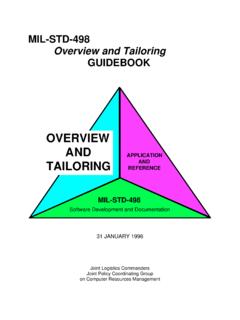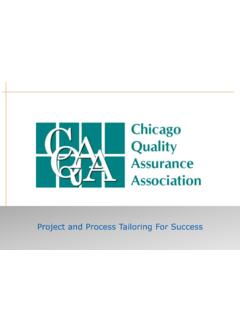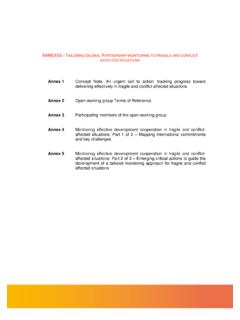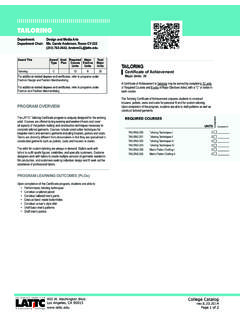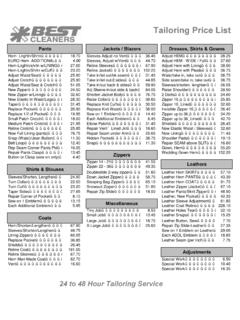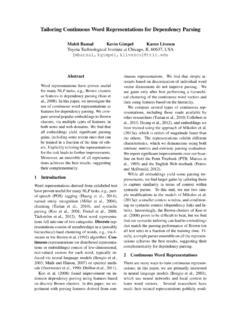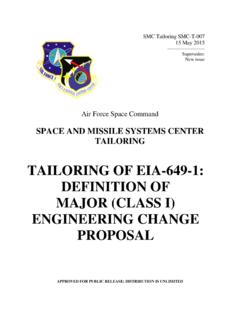Transcription of Tailoring the Patent System for Specific Industries
1 Tailoring the Patent System for Specific Industries John R. Thomas Visiting Scholar February 6, 2015 Congressional Research Service 7-5700 R43264 Tailoring the Patent System for Specific Industries Congressional Research Service Summary Congressional interest in the Patent System has been demonstrated by the enactment of the Leahy-Smith America Invents Act (AIA) in the 112th Congress. Most of the provisions of the AIA apply to any type of patented invention, whether it consists of a chemical compound, mechanical device, electrical circuit, or other technology. However, other AIA provisions are Specific to particular types of inventions, including business methods, tax strategies, and human organisms. The AIA reflects the principle that, for the most part, patentable inventions are generally subject to the same statutory provisions. However, a number of exceptions exist to this concept of technological neutrality.
2 This blended architecture has for many years prompted inquiry into whether the Patent System operates best as a uniform System that applies neutrally to all inventions, or whether it could or should be tailored to meet the Specific needs of different Industries . Technologies and industrial sectors arguably differ in ways salient to the Patent System . Among these distinctions are the costs and risks of research and development, the availability of trade secret protection as an effective alternative to patenting, the number of patents that cover a particular product, and the patterns of Patent acquisition and enforcement of firms within that sector. The Patent System involves a number of parameters that could potentially be adjusted to meet the needs of individual sectors, including the speed with which applications are reviewed, the scope of exclusive rights afforded by a Patent , and the term of the Patent .
3 While some observers suggest the desirability of sector- Specific Patent principles, others believe them to be infeasible and unwise. They observe that legislative efforts to define particular Industries may prove difficult, that attorneys may sometimes be able to draft patents artfully so as to fall within a favored category, and that industry is dynamic and resistive to a static statutory definition. In addition, membership within the World Trade Organization (WTO) may limit the ability to tailor the Patent System to account for different Industries and inventions, to the extent that compliance with WTO standards is desired. The WTO-administered Agreement on Trade-Related Aspects of Intellectual Property, or TRIPS Agreement, in part requires WTO member states to make Patent rights available without discrimination as to the field of technology. The TRIPS Agreement admits some exceptions exist to this principle of technological neutrality, however.
4 Should Congress believe current circumstances to be appropriate, then no action need be taken. To the degree WTO compliance is desired, Congress could also legislate along the lines permitted by the TRIPS Agreement. Notably, although the TRIPS Agreement generally disallows discrimination with respect to technological fields, it permits distinctions on other grounds. Congress could also make use of regulatory exclusivities and other complementary intellectual property rights that the TRIPS Agreement regulates less heavily. Tailoring the Patent System for Specific Industries Congressional Research Service Contents Introduction .. 1 Patent Fundamentals .. 2 The Role of Patents Within Different Industries .. 4 Implications for the Patent System .. 5 The Feasibility of Sector- Specific Patent Rules .. 9 Concluding Observations .. 12 Contacts Author Contact 13 Tailoring the Patent System for Specific Industries Congressional Research Service 1 Introduction The recent enactment of the Leahy-Smith America Invents Act (AIA)1 demonstrates congressional interest in the Patent System .
5 Most of the provisions of the AIA apply to any type of patented invention. For example, the first-inventor-to-file priority System ,2 prior user rights,3 and post-grant and inter partes review proceedings4 apply equally to chemical compounds, electrical appliances, mechanical devices, and any other invention that may be protected by a Patent . However, other AIA provisions are Specific to particular types of inventions. That statute limited the availability of patents on tax strategies,5 prohibits the issuance of patents claiming human organisms,6 and creates transitional proceedings that apply exclusively to patents pertaining to business The AIA also allows prioritization of examination of applications for products, processes, or technologies that are important to the national economy or national 8 The AIA reflects the principle that, for the most part, the Patent System operates in a uniform manner.
6 All patentable inventions are generally subject to the same statutory A number of exceptions exist to this concept of technological neutrality, however. For example, statutory provisions limit the enforceability of patents claiming methods of medical treatment;10 call for Patent term extension for certain products regulated by the Food and Drug Administration (FDA);11 and establish specialized patents for designs and This blended architecture has for many years prompted inquiry into whether the Patent System operates best as a uniform System that applies neutrally to all inventions, or whether it could or should be tailored to meet the Specific needs of different Commentators have proposed, for example, that software patents should receive shorter terms than patents on other inventions,14 and that patents on genes should be subject to compulsory licenses that allow individuals to use the patented technology upon paying a license Unenacted legislation in 1 112-29, 125 Stat.
7 284 (2011). See CRS Report R42014, The Leahy-Smith America Invents Act: Innovation Issues, by John R. Thomas. 2 Ibid. at 3. 3 Ibid. at 5. 4 Ibid. at 6. 5 Ibid. at 14. 6 Ibid. at 33. 7 Ibid. at 18. 8 Ibid. at 25. 9 Clarisa Long, Our Uniform Patent System , 55 The Federal Lawyer (2008), 44. 10 35 287(c). 11 35 156. 12 35 161, 171. 13 Michael W. Carroll, One Size Does Not Fit All: A Framework for Tailoring Intellectual Property Rights, 70 Ohio State Law Journal (2009), 1361. 14 Mark H. Webbink, A New Paradigm for Intellectual Property Rights in Software, Duke Law & Technology Review (2005), 12. 15 Daniel M. Lorentzen, Do These Genes Fit? Genes as Patentable Subject Matter, 60 Drake Law Review (2012), 933. Tailoring the Patent System for Specific Industries Congressional Research Service 2 the 112th Congress, 6245, proposed Patent litigation reforms that would apply to patents claiming computer software and hardware, but not to other sorts of inventions.
8 Notably, membership in the World Trade Organization (WTO) may influence congressional willingness to promulgate industry- Specific Patent statutes. One component of the WTO agreements, the Agreement on Trade-Related Aspects of Intellectual Property Rights (TRIPS Agreement),16 requires patents to be available and enforceable without discrimination as to .. the field of 17 Although the TRIPS Agreement allows for some limited exceptions to this rule of technological neutrality,18 one consequence of membership in the WTO may be a restricted ability to tailor the Patent statute to particular inventions and This report considers the possibility of modifying the Patent System to meet the needs of Specific Industries . After providing a brief review of the Patent System , the report identifies different industrial traits, such as the pace of innovation, product cycle, and the cost of research and development, which potentially suggest the desirability of tailored Patent rights.
9 It then considers possible points of adjustment within the Patent System , including Patent term, scope of exclusive rights, and the availability of remedies for infringement. The report then discusses potential difficulties associated with distinguishing among Industries within the Patent System , including the provisions of the TRIPS Agreement. The report closes with concluding observations. Patent Fundamentals The Patent System covers a broad variety of patents cover traditional subject matter such as machines, pharmaceuticals, and manufacturing processes, along with high-tech inventions in the fields of biotechnology, computer software, and nanotechnology. No matter what the sort of technology, however, the Patent System in large measure operates under the same general principles. In particular, all inventors who wish to obtain Patent rights must file an application at the Patent and Trademark Office (USPTO).
10 USPTO examiners then review the application to ensure that certain statutory requirements are met. These statutory requirements including that the invention be adequately described in the Patent application,21 and that the invention must not have been obvious to a skilled artisan22 apply to every invention for which a Patent is sought. Similarly, once a Patent has issued, the statutory term is set uniformly to 20 years from the date of filing no matter what the type of All patents received the identical exclusive rights 16 Agreement on Trade-Related Aspects of Intellectual Property Rights, April 15, 1994, Marrakesh Agreement Establishing the World Trade Organization, Annex 1C, 1869 299 (1994). 17 Ibid. at Art. 27. 18 Ibid. 19 Dan L. Burk & Mark A. Lemley, Is Patent Law Technology- Specific ?, 17 Berkeley Technology Law Journal (2002) 1155.










